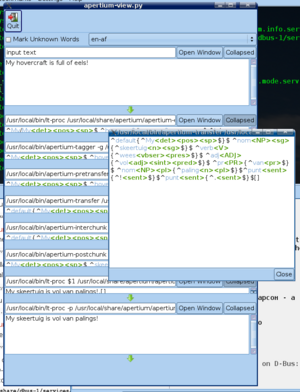Difference between revisions of "Apertium-view"
| Line 20: | Line 20: | ||
== Running apertium-view == |
== Running apertium-view == |
||
If you installed the D-Bus service for Apertium correctly, Apertium-view should just work (you should only have to run <code>python apertium-view.py</code>). If it fails to start up, then there might be a problem with your D-Bus setup. Have a look at the [[D-Bus_service_for_Apertium|D-Bus page]] for possible solutions, or come and ask for help in #apertium on irc.freenode.net. |
|||
=== Configuring apertium-view === |
|||
Edit the contents of <code>config.py</code> to reflect you installation setup. |
|||
<code>apertium_bin_path</code> is the path of the directory containing the Apertium executables. <code>apertium_dict_path</code> is the path to directory on your computer containing all of the compiled language pairs. On my computer it's <code>/usr/local/share/apertium</code>. This directory contains <code>apertium-en-af</code>, <code>apertium-en-ca</code>, etc. |
|||
If you want to use syntax highlighting, you need to copy apertium.lang to a place where Gtksourceview can find it. In Ubuntu 7.10, this directory is at |
|||
<pre> |
|||
/usr/share/gtksourceview-2.0/language-specs/ |
|||
</pre> |
|||
=== Executing the program === |
|||
Apertium-view is very user-hostile at the moment and it won't even properly tell you what you did wrong if you pass it the wrong flags. |
|||
The format is |
|||
<pre> |
|||
$ python apertium-view.py <language code> <modes file path> [<mode code>] |
|||
</pre> |
|||
The language code is something like <code>en-af</code> or <code>en-ca</code>. The modes path is the path to your modes XML file. The mode code is optional and refers to the name of a mode in the modes file; if you omit it, the first mode is used. |
|||
==Feature requests== |
==Feature requests== |
||
Revision as of 19:00, 14 December 2007
Apertium-view is a little program which can be used to view and edit the output of the various stages of an apertium translation.
The various stages update while you type, and a change made in any one pane updates the subsequent stages.
Currently, the program is in its early stages and it will take some time before it becomes fully usable. But if you are a developer with some knowledge of Python and PyGTK, you can already dive in.
What you need
- The Apertium D-Bus Service
- A working Apertium 3.0 installation (note: this must be installed)
- The python bindings for the GTK SourceView V 2.0 module if you want syntax highlighting
Getting apertium-view
Check out the apertium-tools/apertium-view from the subversion repository.
Running apertium-view
If you installed the D-Bus service for Apertium correctly, Apertium-view should just work (you should only have to run python apertium-view.py). If it fails to start up, then there might be a problem with your D-Bus setup. Have a look at the D-Bus page for possible solutions, or come and ask for help in #apertium on irc.freenode.net.
Feature requests
Removing scrollbars when not wanted.Allow users to set 'mark unknown words' or not.- Automatically resizing panes to fill the screen (when others are minimised)
- Syntax highlighting
- tags are #aaaaaa, ^ and $ are #009900 { } are #999900 @ * # are #990000 and [] are #aaaaff
- Moving chunks as units rather than text.
- Configuration / choosing language pair in the GUI.
- Option to be able to click on an analysis to remove it. (basically, when you click in between / /, it removes the part in between. Would need CTRL+Z to be able to restore analyses (see below).
- Some kind of undo on a per text-pane/stage basis.
Ability to detach windows (particularly input and output windows).- Scroll panes down when they fill with more information.
Related software requests
- A simple GUI program with an input window and an output window. It could be turned into a version of apertium-view.
